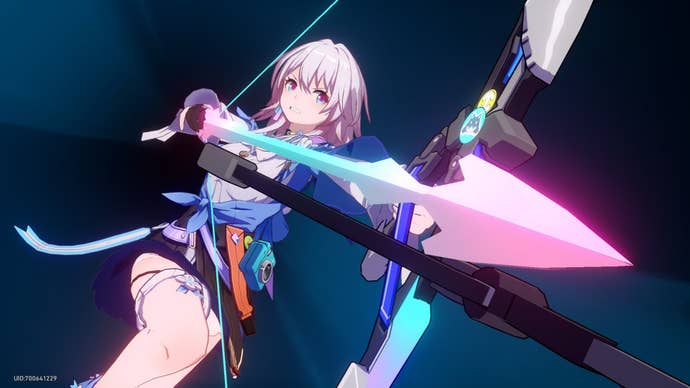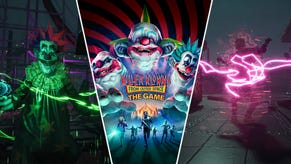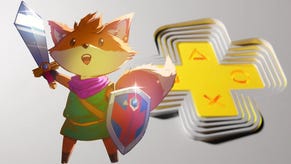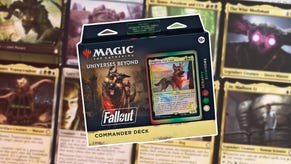As Honkai: Star Rail turns one, we look back on the Genshin Impact successor that might just outshine its blockbuster older sibling
We're all living in a gacha game world now, but who holds the throne of the F2P empire? Figuring it out isn't as simple as you think.
In a year almost unprecedentedly packed with brilliant game releases, Honkai: Star Rail — which today celebrates the first anniversary of its release — nevertheless stands out as a 2023 success story. A low-key one, admittedly; it wasn't hugely lauded at the end of the year, receiving only three nominations across all five major game award shows and winning just one (Best Mobile Game at The Game Awards) — although it did sweep up every gong it could at several smaller and more mobile-focussed ceremonies.
But not only did Star Rail review positively among critics, it's been an enormous hit with the gaming public: boasting nearly 22 million estimated players in the past month according to the unofficial tracker ActivePlayer.io, and spending several months since its launch vying with Genshin Impact for the title of the top-earning gacha game, even managing to beat its predecessor into second place on more than one occasion.
There are a number of potential reasons why one of the most popular games going right now is often detached from wider conversations around gaming. Despite being available on both PC and PlayStation 5 as well as iOS and Android devices, Honkai: Star Rail is almost exclusively talked about in critical circles as a mobile game, perhaps because its free-to-play gacha monetisation model indelibly associates it with those platforms in many peoples' minds.
Your viewpoint may vary on whether this represents a certain snobbishness towards the interests of players who favour F2P and/or mobile gaming — often treated as an inconsequential minority, despite estimates generally suggesting that around 60% of all gamers worldwide play on mobile devices — or a laudable refusal to give too much publicity to games monetised through gachas, which are often regarded (not unfairly) as innately predatory. The truth probably lies somewhere in the middle, but nevertheless, it's my personal feeling that Honkai: Star Rail's F2P, mobile-led status meant it missed out on some of the recognition it deserved as genuinely one of the most entertaining new games of 2023.

Honkai: Star Rail is developed by Chinese studio miHoYo (now known as HoYoverse in international markets), and is their fourth game to receive an official launch outside of Asia. Honkai Impact 3rd and Tears of Themis gained the company a decent-sized fanbase among Western gamers, but it was the launch in 2020 of their sprawling fantasy RPG Genshin Impact that put the studio on the map outside of the mobile gaming niche. Genshin — which is also available on PC, PS4, and PS5 — became at the very least a notable curio thanks to its ambitious scope and high production values, with its Breath of the Wild-inspired open world particularly noted as basically unique in the single-player F2P/mobile space.
Given that a large part of its appeal lay in the fact that there was nothing else quite like it out there — at least, not playable for free — Genshin Impact was always going to be a tough act to follow. But HoYoverse wasted no time in getting to work on their next two games, Honkai: Star Rail and the upcoming Zenless Zone Zero (which earlier this week received a tentative July 2024 release date) — even while putting out regular updates to their existing suite of live service titles.
With so many plates spinning within HoYoverse and plenty of competition on the mobile gaming scene more generally, expectations going into Honkai: Star Rail weren't especially high. Particularly given the fact that HoYo elected not only to jettison their signature action fighting style in favour of their first foray into turn-based systems, but also to make no attempt to repeat the vast open world style that had been such a huge talking point around Genshin's release, the general feeling was that this one would be for the studio's diehard fans but wouldn't be able to recapture the lightning in a bottle that was Genshin Impact.

Admittedly, despite their ongoing nail-biting battle to rake in the most obscene revenue, HSR hasn't yet quite managed to compete with Genshin in player numbers: during the same month that saw 22 million people log in to their Star Rail accounts, over 60 million people played Genshin Impact (again, thanks ActivePlayer.io!). But considering how unstoppable Genshin sometimes appears as that one gacha game adamantly non-mobile gamers will occasionally admit to playing, the fact that Star Rail has managed to come for the king financially while steadily maintaining a player base a respectable one-third the size of its colossal sibling's is pretty impressive.
For further comparison, Star Rail's player count last month was about 1/10 the size of Fortnite's in the same time period — so not the biggest game on the planet, sure, but it's strange to think how relatively rarely it gets discussed outside of its niche, considering that it can pretty comfortably stand on the same playing field as the game that actually might be. Truly, I don't think this time last year anyone expected HSR to have a player base that could even be meaningfully measured on the same scale as honest-to-goodness Fortnite.
Ultimately, though, while these numbers are interesting, it wouldn't mean much to me personally if I hadn't developed such an affectionate relationship with Honkai: Star Rail over the past year. You see quite a lot of live service games in this job, and it's fair to say that HoYoverse's output are among the very few I haven't bounced off of as soon as the initial push for launch coverage was over.

I've been asked, on occasion, why I hold such fondness for these games when there are surely more prestigious titles out there competing for my attention and time, and I have to tell you the plain truth here, which is that I just think HoYoverse make very good games. This is thanks in large part to their interesting settings, compelling characters, satisfying combat, and music that will come to dominate your Spotify playlists. What's more, they're translating lessons learned from older titles into improvements for their newer ones, which is bold of them considering that the temptation to let HSR be "Genshin in space" with no further tweaks to that winning formula must have been high.
Admittedly, when you strip away the veneers of high fantasy vs space opera and ARPG vs JRPG, Genshin and Star Rail are built upon a near-identical basic structure. The offputtingly numerous currencies you can plug into each game's gacha are essentially just reskins of one another, as are the character building considerations, quest types, difficulty level scaling, and so on. But quality of life in Star Rail is much higher, which often has the side effect of exposing the increasingly creaky architecture Genshin is built upon; and in that sense, I can almost begin to understand how HSR can pull in roughly equal revenue from only one-third of the players. I'm F2P all the way, but if I had to pay for one of these games, it would be Star Rail, hands down.
Star Rail, for example, still lets you play most of its time-limited events after they've officially ended, just without the special rewards at the end, meaning that you don't miss out on chunks of the story as you do if you miss the boat in Genshin. This makes it a much friendlier prospect for new players joining the game well after launch, or just for those of us who don't actually want to play every day — and indeed, might only log in occasionally as the mood strikes.
On the surface it's maybe counterintuitive — driving players to play every day through FOMO is a huge part of how games like these make their bank — but it makes the game far more accessible, especially if you mainly play for the story and characters. An optimist might cite this as an example of HoYoverse valuing player experience over maximising profits, and while I think there's a grain of truth in this, I think it's also based on a canny understanding of the fact that players who don't fall dishearteningly behind every time they take a few weeks off will ultimately be more likely stick around for the long-haul.

There are lots of other similar tweaks that make Star Rail a slightly smoother experience than Genshin. The end-game grind for the best character and weapon levelling materials is still present but is significantly less grindy, being both more streamlined in the range of different items you'll need to run around collecting and more generous with their drop rates. Starting party members are featured on gacha banners with the same regularity as other 4-star units, averting Genshin's puzzling tendency to make some of the most basic characters among the hardest (and potentially most costly) to build up. I could go on, but I'm sure you don't need a comprehensive list to get the idea.
Somewhat controversially, Honkai: Star Rail has also so far featured more generous special rewards than Genshin Impact, which has been consistently criticised throughout its lifespan for being stingy compared to other, similar gacha games, including the Honkai series. Unlike F2P games more generally, which can cheerfully make you pay through the nose for anything beyond basic access to the game, gacha games are traditionally expected to dish out some decent freebies a few times a year — be it for launch anniversaries or real-world celebrations such as Chinese New Year. It's perhaps not so much the case that Star Rail is especially generous with its regular doling out of special currencies and 5-star characters, but that Genshin is resting on its laurels a bit.
Some of the more extreme fan speculations have it that the Honkai series is being given preferential treatment internally at HoYoverse in an effort to undermine the popularity of their flagship stand-alone title, although there are a couple of less bafflingly conspiratorial explanations. For one thing, Genshin is helmed by a different lead producer to the person responsible for overseeing both Honkai: Star Rail and Honkai Impact 3rd, which might easily account for why the Honkai games' player incentives resemble one another but differ from Genshin's.
There's also, perhaps, the fact that HSR simply needs to stay ahead of the competition in a mobile market that features way more turn-based games than open-world RPGs, even if it did get a leg up in popularity because of HoYoverse's pedigree in the sector.

One year in, Honkai: Star Rail clearly isn't about to eclipse Genshin Impact in terms of player numbers or even revenue. But it could well be on track to become the Miss Congeniality of HoYoverse games. A skim of the relevant forums and subreddits reveals that dedicated HSR players generally seem happier overall with their game than Genshin's die-hards, while more casual players appreciate the fact that there are fewer barriers to just dipping in occasionally to enjoy the story — which, for what it's worth, I think is quite a bit better than that of Genshin Impact.
If anything, though, I'm mainly impressed that HoYoverse has so far managed not to fatally cannibalise its own market with its four (soon to be five) concurrently active live service titles.
And I'm pleasantly surprised by the fact that Honkai: Star Rail is able to stand on its own as an impressive and enjoyable game that showcases the best of what HoYoverse can do creatively, something that deserves to go down as far more than a footnote to the studio's Genshin success.









